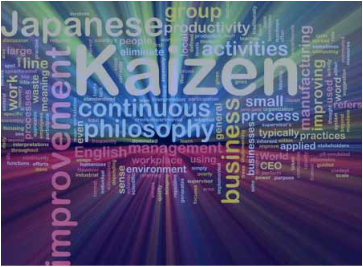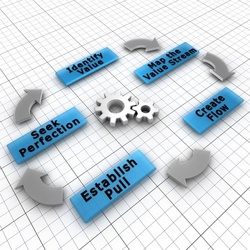LEAN DEPLOYMENT (KAIZEN)

Lean is a set of tools and techniques used to attack "waste" in your company from a customer perspective. This is any activity you are currently performing that isn't adding value to the product or service you're providing, but from the perspective of the customer and not your internal organization.
Lean is often best applied by focusing on critical value streams in your business. This may take the form of an order fulfillment process, manufacturing process or line, a logistics process, service delivery process, etc. Once a target Value Stream is identified, techniques like Value Stream Mapping are used to identify value added versus non-value added work. Thorough understanding of current state allows redesign of the process to simplify and standardize around the value added work, or Standard Work. Of course, these are just two of the many tools and techniques used to streamline and create Continuous Flow. Others include 5S, Mistake Proofing, Visual Controls, daily Preventative Maintenance and Setup Reduction.
Lean is often best applied by focusing on critical value streams in your business. This may take the form of an order fulfillment process, manufacturing process or line, a logistics process, service delivery process, etc. Once a target Value Stream is identified, techniques like Value Stream Mapping are used to identify value added versus non-value added work. Thorough understanding of current state allows redesign of the process to simplify and standardize around the value added work, or Standard Work. Of course, these are just two of the many tools and techniques used to streamline and create Continuous Flow. Others include 5S, Mistake Proofing, Visual Controls, daily Preventative Maintenance and Setup Reduction.

To further enhance flow, Lean expands its focus to demand-driven scheduling and replenishment of the supporting resources needed by the Value Stream. The concept of "Pull" is introduced into the process - the chain reaction that should be created when a customer creates demand for the process. These demand-driven replenishment processes will optimally be designed to provide just-in-time support for the Value Stream all the way back into the Supply Base.
Of course, as any operations person will tell you, some of the biggest sources of "waste" are driven by defects and variation in the process. That is why it's practically insane to consider Lean deployment without utilizing Six Sigma tools to address product of service quality improvement, variation issues and defect reduction. This usually isn't an event but a journey of constantly improving the process, and sometimes the product or service, to allow it to be more easily manufactured or easily delivered to the customer.
A Lean process starts with the customer view, is driven by customer demand and is all about providing customer value. After all, serving the customer usually equates to success in making money, which is the number one goal of most businesses!
Of course, as any operations person will tell you, some of the biggest sources of "waste" are driven by defects and variation in the process. That is why it's practically insane to consider Lean deployment without utilizing Six Sigma tools to address product of service quality improvement, variation issues and defect reduction. This usually isn't an event but a journey of constantly improving the process, and sometimes the product or service, to allow it to be more easily manufactured or easily delivered to the customer.
A Lean process starts with the customer view, is driven by customer demand and is all about providing customer value. After all, serving the customer usually equates to success in making money, which is the number one goal of most businesses!

